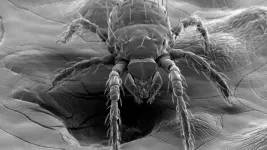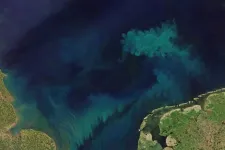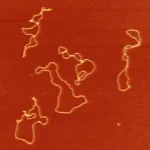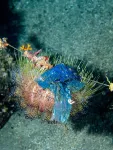(Press-News.org) NEWPORT, Ore. – Rates of Chinook salmon bycatch in the Pacific hake fishery rise during years when ocean temperatures are warmer, a signal that climate change and increased frequency of marine heatwaves could lead to higher bycatch rates, new research indicates.
During years when sea surface temperatures were higher, including during a marine heatwave, Chinook salmon were more likely to overlap with the Pacific hake and raise the risk of bycatch as they sought refuge from higher temperatures.
The findings, based on 20 years of bycatch data and ocean temperature records, provide new insight into the ecological mechanisms that underlie bycatch, which is the incidental capture of a non-targeted species, said the study’s lead author, Megan Sabal.
“The impact of ocean warming on bycatch has potential cultural, economic and ecological consequences, as the hake and salmon fisheries are each worth millions of dollars and salmon are critical to both Indigenous tribes’ cultural heritage and healthy ecosystems,” said Sabal, who worked on the project as a postdoctoral scholar at Oregon State University.
Pacific hake, also known as Pacific whiting, is the largest commercial fishery by tonnage on the U.S. West Coast. The rate is low but bycatch remains a concern for the Chinook salmon population, said Michael Banks, a marine fisheries genomics, conservation and behavior professor at Oregon State University and a co-author of the study.
“The hake fishing industry is very sensitive to the impacts of bycatch on salmon and has been diligent in reducing it, but changing climate conditions might become an increasing issue,” he said.
The research was just published in the journal Fish and Fisheries.
Pacific hake school in midwater depths off the West Coast from southern Baja California to the Gulf of Alaska. Hake is commonly used in surimi, a type of minced fish used to make imitation crab.
Most hake fishing occurs at depths of 200 to 300 meters and Chinook salmon typically occupy more shallow depths. If changing water temperature affects salmon distribution, that could increase salmon bycatch, the researchers noted.
“Developing a mechanistic understanding of how environmental conditions might impact bycatch can help us prepare for the future and think about how to adapt current strategies to keep up with a changing world,” said co-author Kate Richerson of the National Oceanic and Atmospheric Administration’s Northwest Fisheries Science Center Newport Research Station.
To better understand the impacts of changing ocean conditions, the researchers tapped into 20 years of data collected through NOAA’s At-Sea Hake Observer Program. Observers are placed aboard hake catcher-processor vessels and motherships that receive catch to process and record information about fishing depth and location, species composition and more.
Sabal and her coauthors modeled observer data and genetic stock identification to show salmon moving lower into the water column during higher temperatures.
“These behavioral changes can provide important information for researchers and can also inform creative conservation solutions,” Sabal said.
The researchers also found that limiting night fishing, a common mitigation strategy to reduce bycatch, will likely become less effective when sea surface temperatures are warmer near the surface.
The findings suggest that new strategies may be needed to continue mitigating bycatch in the hake fishery, Banks said. As technology improves, fishermen and fishery managers might be able to forecast bycatch impacts based on real-time ocean condition information and make adaptive management decisions about fishing strategy based on those conditions.
“As the oceans and the world are changing, the conflict between the two fisheries is showing up in new ways,” he said, “and we may need to shift strategies based on this understanding.”
Banks is affiliated with OSU’s Department of Fisheries, Wildlife, and Conservation Sciences in the College of Agricultural Sciences and the Coastal Oregon Marine Experiment Station at Hatfield Marine Science Center. Sabal was affiliated with the Cooperative Institute for Marine Ecosystems and Resources Studies and the Coastal Oregon Marine Experiment Station while working on the project and now works for the Oregon Department of Fish and Wildlife as a quantitative fisheries scientist.
Additional coauthors are Taal Levi of OSU’s College of Agricultural Sciences and Paul Moran and Vanessa Tuttle at NOAA’s Northwest Fisheries Science Center in Seattle.
END
Warmer ocean temperatures increase risk of salmon bycatch in Pacific hake fishery
2023-07-12
ELSE PRESS RELEASES FROM THIS DATE:
Bacterium associated with disease found in NC chiggers
2023-07-12
July 12, 2023
Bacterium Associated With Disease Found in N.C. Chiggers
EMBARGOED FOR RELEASE UNTIL NOON EDT ON WEDNESDAY, JULY 12
A bacterium that causes a disease called scrub typhus – a disease not previously reported in the United States – has been detected in North Carolina, according to a new study by researchers at North Carolina State University and UNC-Greensboro.
The researchers stress that scrub typhus, which can cause fever, headache and body aches – and can be fatal if left untreated by antibiotics – has not yet been ...
Mass General Brigham researchers make key improvements to Parkinson’s disease cell therapies
2023-07-12
Researchers at McLean and Mass General Hospital demonstrated that a transplant surgical procedure (called “needle trauma”) triggers a profound immune response and causes the death of most grafted dopamine neurons
They also found that co-transplantation of neuronal cell therapy with host regulatory T cells resulted in effective suppression of needle trauma and significant improvement in the survival and recovery of grafts
Findings suggest a path for the ‘realistic’ use of cell therapy to treat neurodegenerative disorders
Cell therapy holds promise as a new treatment for Parkinson’s disease but, in many trials to date, most transplanted dopamine ...
County-level income inequality, social mobility, and deaths of despair in the US
2023-07-12
About The Study: This study found that the joint exposure of unequal income distribution and lack of social mobility was associated with additional risks for deaths of despair (deaths from suicide, drug overdose, and alcohol-related liver disease), suggesting that addressing the underlying social and economic conditions is crucial in responding to the epidemic of deaths of despair.
Authors: Chun-Tung Kuo, Ph.D., of National Taiwan University in Taipei, is the corresponding author.
To access the embargoed study: Visit our ...
Trends in acute care use for mental health conditions among youth during pandemic
2023-07-12
About The Study: Into the second year of the pandemic, mental health emergency department visits increased notably among adolescent females, and there was an increase in prolonged boarding (waiting in an emergency department or medical inpatient unit) of youth awaiting inpatient psychiatric care. Interventions are needed to increase inpatient child psychiatry capacity and reduce strain on the acute mental health care system.
Authors: Haiden A. Huskamp, Ph.D., of Harvard Medical School in Boston, is the corresponding author.
To access the embargoed study: Visit our For The Media website at this link https://media.jamanetwork.com/
(10.1001/jamapsychiatry.2023.2195)
Editor’s ...
Study: The ocean’s color is changing as a consequence of climate change
2023-07-12
CAMBRIDGE, MA -- The ocean’s color has changed significantly over the last 20 years, and the global trend is likely a consequence of human-induced climate change, report scientists at MIT, the National Oceanography Center in the U.K., and elsewhere.
In a study appearing today in Nature, the team writes that they have detected changes in ocean color over the past two decades that cannot be explained by natural, year-to-year variability alone. These color shifts, though subtle to the human eye, have occurred over 56 percent of the world’s oceans — an expanse that is larger than ...
DNA element with a murky past is borrowing cell’s repair machinery
2023-07-12
Like its viral cousins, a somewhat parasitic DNA sequence called a retrotransposon has been found borrowing the cell’s own machinery to achieve its goals.
In a new work appearing online Wednesday in the journal Nature, a Duke University team has determined that retrotransposons hijack a little-known piece of the cell’s DNA repair function to close themselves into a ring-like shape and then create a matching double strand.
The finding upends 40 years of conventional wisdom saying these rings were just a useless by-product of bad gene copying. It may also offer new insights into cancer, viral infections and immune responses.
Retrotransposons are segments ...
Plastic pollution on coral reefs increases with depth and mostly comes from fishing activities, Nature study finds
2023-07-12
SAN FRANCISCO, CA (July 12, 2023) — In a paper published today in Nature, researchers from the California Academy of Sciences, University of São Paulo, University of Oxford, University of Exeter, and other collaborators reveal the extent of plastic pollution on coral reefs, finding that debris increases with depth, largely stems from fishing activities, and is correlated with proximity to marine protected areas.
Through underwater visual surveys spanning more than two dozen locations across the Indian, Pacific, and Atlantic ...
Mast cells as a sensor: Enigmatic immune cells help to avoid harmful allergens
2023-07-12
The function of mast cells, which are part of the immune system, is still a mystery. Scientists at the German Cancer Research Center (DKFZ) have now shown in mice: mast cells function as a sensor that signals the animals to avoid antigens, including harmful allergens, and thereby protect themselves from health-threatening inflammatory reactions. The findings were published in the journal Nature.
Mast cells are found primarily in tissues that separate the outside and inside worlds of the body, such ...
Detailed map of the heart provides new insights into cardiac health and disease
2023-07-12
In a new study, published today (12 July) in Nature, researchers have produced the most detailed and comprehensive human Heart Cell Atlas to date, including the specialised tissue of the cardiac conduction system - where the heartbeat originates.
The multi-centre team is led by the Wellcome Sanger Institute and the National Heart and Lung Institute at Imperial College London, and has also presented a new drug-repurposing computational tool called Drug2cell, which can provide insights into the effects of drugs on heart rate.
This study is part of the international Human Cell Atlas* ...
Second year of COVID pandemic brought spike in child mental health visits to ED
2023-07-12
The number of young people in the United States visiting hospital emergency departments for mental health crises increased sharply during the second year of the COVID-19 pandemic, according to a study led by researchers from the Department of Health Care Policy in the Blavatnik Institute at Harvard Medical School. The findings are published Jul 12 in JAMA Psychiatry.
These results come amidst growing national concern about a crisis in youth mental health and provide important new details about how young people with mental health problems such as self-harm ...



